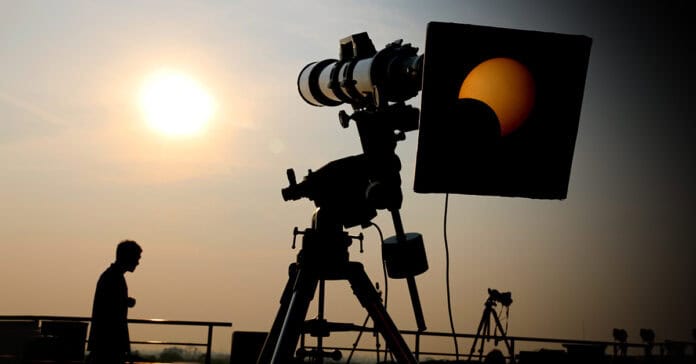A rare hybrid solar eclipse will be visible on Thursday in some parts of the world, including Exmouth and Barrow Island in Western Australia, as well as eastern regions of Timor-Leste and West Papua in Indonesia. Astronomy enthusiasts in other parts of Australia and the world will still be able to witness a partial eclipse.
Dr. Brad Tucker, an astrophysicist affiliated with the Australian National University, elucidates that solar eclipses transpire when the moon traverses between the sun and Earth.
Total solar eclipses, wherein the sun is entirely concealed by the moon, occur approximately once every 18 months; however, for one to reoccur at an identical location on Earth, an average of 375 years is required.
Hybrid Eclipse: A Distinctive Amalgamation of Total and Annular Eclipses
The forthcoming solar eclipse is distinctive, as it constitutes a hybrid eclipse, states Tanya Hill, the lead curator of astronomy at Museums Victoria.
The phenomenon will commence as an annular eclipse above the Indian Ocean, where the moon is marginally too diminutive to entirely obstruct the sun, leaving a halo of sunlight perceptible.
As the moon’s shadow reaches terrestrial territory, it will metamorphose into a total eclipse, with the moon now sufficiently expansive to wholly obscure the sun.
The total solar eclipse will materialize over Australia’s Ningaloo region, encompassing Exmouth, commencing at 11:29 am (AWST) and enduring approximately one minute.
Inhabitants of other regions in Australia will be able to witness a partial eclipse, with the sun being obscured to varying degrees.
Observe the Eclipse Online via NASA’s Livestream
For individuals incapable of experiencing the hybrid solar eclipse in person, NASA will furnish a YouTube livestream of the event.
The eclipse is anticipated to initiate at 9:34 pm EST on April 19 and culminate at 2:59 am on April 20. In Universal Time (UTC), the eclipse occurs exclusively on Thursday.
NASA has also assembled a catalog of impending eclipses through a minimum of 2025 on their website. A few of these forthcoming events encompass an annular solar eclipse on October 14, 2023, and a total solar eclipse in April 2024.
Safety Precautions While Observing Solar Eclipses
While witnessing a solar eclipse can be an awe-inspiring experience, it is crucial to take proper safety precautions to protect your eyes. Looking directly at the sun without appropriate protection can cause permanent damage to your eyesight.
To safely observe a solar eclipse, you can use solar viewing glasses or eclipse glasses, which are specifically designed to block out harmful solar radiation. Regular sunglasses, even with very dark lenses, are not sufficient to protect your eyes.
Another safe way to watch a solar eclipse is through a pinhole projector. This simple device allows you to project an image of the eclipsed sun onto a surface, such as a piece of paper or a wall.
You can easily make a pinhole projector at home using a cardboard box, aluminum foil, and white paper.






